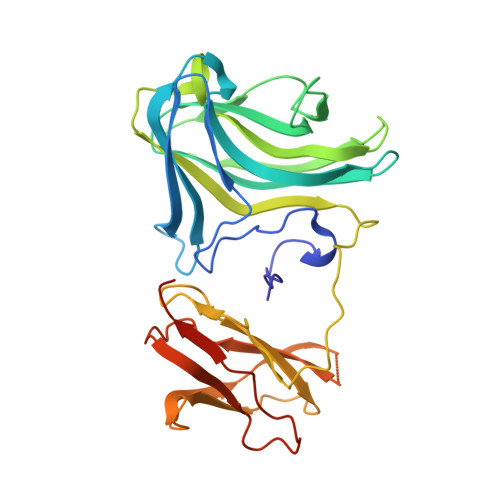The unique binding mode of cellulosomal CBM4 from Clostridium thermocellum cellobiohydrolase A.
Alahuhta, M., Xu, Q., Bomble, Y.J., Brunecky, R., Adney, W.S., Ding, S.Y., Himmel, M.E., Lunin, V.V.(2010) J Mol Biol 402: 374-387
- PubMed: 20654622
- DOI: https://doi.org/10.1016/j.jmb.2010.07.028
- Primary Citation of Related Structures:
3K4Z - PubMed Abstract:
The crystal structure of the carbohydrate-binding module (CBM) 4 Ig fused domain from the cellulosomal cellulase cellobiohydrolase A (CbhA) of Clostridium thermocellum was solved in complex with cellobiose at 2.11 A resolution. This is the first cellulosomal CBM4 crystal structure reported to date. It is similar to the previously solved noncellulosomal soluble oligosaccharide-binding CBM4 structures. However, this new structure possesses a significant feature-a binding site peptide loop with a tryptophan (Trp118) residing midway in the loop. Based on sequence alignment, this structural feature might be common to all cellulosomal clostridial CBM4 modules. Our results indicate that C. thermocellum CbhA CBM4 also has an extended binding pocket that can optimally bind to cellodextrins containing five or more sugar units. Molecular dynamics simulations and experimental binding studies with the Trp118Ala mutant suggest that Trp118 contributes to the binding and, possibly, the orientation of the module to soluble cellodextrins. Furthermore, the binding cleft aromatic residues Trp68 and Tyr110 play a crucial role in binding to bacterial microcrystalline cellulose (BMCC), amorphous cellulose, and soluble oligodextrins. Binding to BMCC is in disagreement with the structural features of the binding pocket, which does not support binding to the flat surface of crystalline cellulose, suggesting that CBM4 binds the amorphous part or the cellulose "whiskers" of BMCC. We propose that clostridial CBM4s have possibly evolved to bind the free-chain ends of crystalline cellulose in addition to their ability to bind soluble cellodextrins.
Organizational Affiliation:
National Renewable Energy Laboratory, 1617 Cole Boulevard, Golden, CO 80401, USA.




















